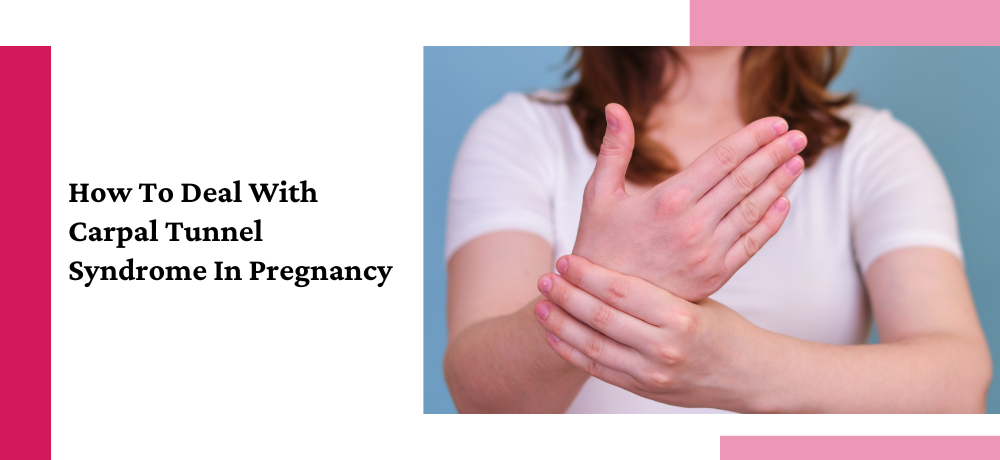How To Deal With Carpal Tunnel Syndrome In Pregnancy

As a mother-to-be or a new mom, you may already know about the common pregnancy pains such as low back pain, sciatica, and symphysis pubis dysfunction. However, there is one pain that you may not be familiar with, and that is carpal tunnel pain. It is a nerve irritation in the wrist and hand that can cause mild to severe discomfort during pregnancy. According to research, up to 62% of pregnant people experience carpal tunnel pain.
So, why is carpal tunnel syndrome so common during pregnancy? This blog post will cover what carpal tunnel pain is, why it can occur during pregnancy and postpartum, and how you can manage the discomfort or painful symptoms.
Carpal tunnel pain is characterized by numbness or tingling in the hands, thumb, or fingers. It could cause pain when extending your wrist, or when putting your hand down on the ground for weight-bearing exercises like planks or push-ups. During pregnancy, the following two changes can cause compression to the median nerve:
1. Increased swelling: Hormonal changes during pregnancy can cause an increase in fluid retention in the body, resulting in swelling (or edema). This swelling can narrow the space within the compartment housing the median nerve.
2. Misalignment in the upper body: The physical changes during pregnancy can cause shifts in your alignment. Specifically, the growing belly often tips the pelvis forward resulting in an excessive lower back arch (or “lumbar lordosis”). This could lead to a more pronounced “kyphosis” in the thoracic spine (AKA rounded shoulders and/or forward head protrusion). This flexion in the thoracic spine can also contribute to compression of the median nerve because the median nerve originates in the neck and runs in front of the shoulder and down the arm.
Carpal tunnel pain can also occur during the postpartum period from all the time spent in a “triple-flexed” position (shoulders, elbows, wrists) from baby carrying.
Now that you know why carpal tunnel pain is common during pregnancy, let's discuss how you can prevent or manage the symptoms.
1. Get in neutral alignment: Getting your body into neutral alignment is one of the biggest improvements you can make to mitigate almost all the common pregnancy pains and injuries — including carpal tunnel pain. Your neck position is most important, so try to keep a straight line between your ear-shoulder-hip — especially when seated.
2. Drink water and reduce sodium intake: Water is important for so many reasons during pregnancy, and reducing swelling is yet another. It helps to “flush” the system out and reduce the accumulation of fluids that could cause compression.
3. Keep moving: Movement throughout pregnancy is also important for many reasons, but specific to mitigating carpal tunnel pain, it improves circulation to reduce swelling.
If you are experiencing painful symptoms — especially during exercise, the following strategies can also help:
1. Perform gentle mobility work: At various times during the day, perform gentle wrist circles in both directions. This can help take pressure off the median nerve.
2. Keep wrists and hands in neutral during exercise: Typically, putting your wrists into extension provokes the most amount of pain. Therefore, you want to keep your wrists in a more neutral position. If pressure on your knuckles hurts, you can also try keeping your wrists in neutral while on a dumbbell.
3. Stick to open-chain vs. closed-chain exercises: Closed-chain exercises are those in which your hands are fixed on a surface (i.e. the ground). Even with modifications of the hand positions, doing closed-chain movements may be too uncomfortable because of the direct downward pressure on your wrists. Therefore, you may want to stick exclusively to open-chain movements, in which your hands are free to move around in space.
4. Keep fingers lengthened during upper body exercises: When performing open-chain exercises, if gripping or making a fist is uncomfortable, then ensure that your fingers are lengthened.
For more persistent pain, you may want to check with a medical provider who can assess your individual case. In general, carpal tunnel pain during pregnancy will ease once the swelling diminishes (after baby is born) but you may be aided by wearing a splint as a reminder to keep your wrists in a neutral position (particularly when on the computer and while sleeping).
As a prenatal and postnatal personal trainer, I understand the discomfort that comes with carpal tunnel pain during pregnancy. That's why I recommend implementing these strategies to manage the pain and prevent further discomfort. Remember, finding your inner strength can help you better structure and navigate experiences that come with motherhood. With my customized framework of strength building tools, we can work together to guide you through any stage of motherhood and help you become the best mom, and person, you can be!
If you're looking for a prenatal or postnatal personal trainer who can guide you through any stage of motherhood and help you become the best mom and person you can be, look no further than Mama Strength. I offer virtual fitness consultations, virtual group classes, and virtual/in-home personal fitness training. Contact me today to learn more about how I can help you achieve your fitness goals and manage pregnancy-related discomfort such as carpal tunnel pain.
To learn more about the services I offer, please click here. If you have questions, I’d love to hear from you. Please feel free to call me at (917) 838-1478 or email me at erin.livingston@mamastrength.com.